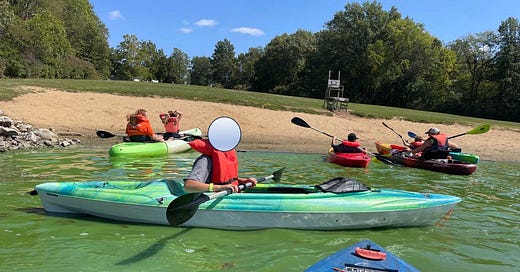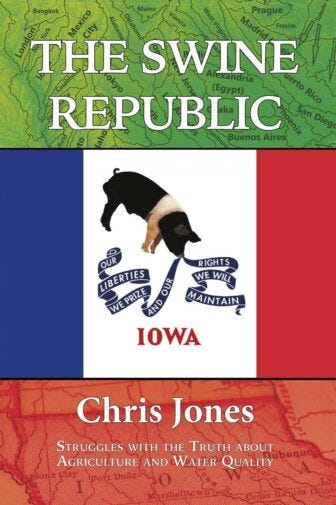A friend of mine sent me the picture below, which was taken at Lake Darling last week. The water feature at Lake Darling State Park in southeast Iowa was restored only nine years ago in 2014 at a cost of $16 million. Unless you’re willing to travel to West Okoboji in the far northwest corner of Iowa, this is what you’re left with if you want to enjoy one of the other 120 or so lakes in our state. The saddest thing to me about that photo is that those children are likely to grow up thinking that this is what a lake should look like.
There is a chapter in my book about Lake Darling that was written in 2019. Around that time, I was sent a map that delineated 19 farm fields within ½ mile of the lake. These fields were included in 35 manure management plans (MMPs). If each of those MMPs correspond to one hog CAFO, and each one has an Iowa average of 3500 hogs (give or take), then manure from approximately 123,000 hogs can be legally applied to those fields.
Iowa DNR (and its predecessor, the Conservation Commission), re-introduced Canada Geese in Iowa from 1967 through 1996 (1). As recently as 1971, there were less than 1000 geese in the state. By 2013, there were about 80,000, and population estimates range from 100,000 to 200,000 now but I’m just going to assume it’s the larger number going forward with this essay.
Lake Darling is in Washington County, which has the most hogs of any Iowa county (1.33 million) (2). As 1 of 99 counties, let’s assume it has 1/99 of Iowa’s geese: about 2000. Let us also assume a goose excretes roughly the same amount of waste as a turkey. According to Iowa DNR (3), a hog excretes 6.3 times as much nitrogen and 3.8 times as much phosphorus as a turkey. The average of those two figures is 5.0, so let’s say a hog excretes about 5 times as much waste as a goose. It's probably bigger than that since the mass of an adult hog is far more than 5 times that of a goose, and a hog is eating and shitting pretty much constantly, whereas a goose is a wild animal and eats like most other wild animals.
Finally, let’s assume all the geese in Washington County call Lake Darling home. If you’re still with me, that means the hog waste on those 19 fields is 300 times the maximum possible goose-borne waste. And bear in mind, these are fields just within ½ mile of the lake. The watershed draining to the lake encompasses 19 square miles and extends about 6 miles from the lake itself as the goose flies.
Norlin Mommsen is a member of the Iowa House from Clinton County. He also says he’s a “farmer, growing corn and soybeans and raising cattle (4).” Norlin once showed his mettle to an audience by walking out of a presentation I was conducting at Drake University. Here’s Norlin saying that the water quality problems at Lake Darling are caused by geese (1 hour 37 minute mark). Interestingly, moments later he hypes the water quality monitoring system that he voted to kill in the last legislative session.
Norlin also likes to think he’s got water quality cred. Here’s a video of him touting that cred. I know there are some people around in academia and elsewhere that do indeed think Norlin has some cred, apparently because he can use ‘water’ and ‘quality’ in the same sentence. The water quality cred bar is pretty low in the Iowa Legislature.
It’s preposterous to think geese are causing the nutrification (excess nitrogen and phosphorus) of our lakes and streams in Iowa (see above calculations) that is manifested in the harmful algae blooms (photo at beginning). This is not to say that prevents guys like Mommsen from believing it or lying about it. But because it’s preposterous, I’m not going to spend any more time on it.
The idea that E. coli impairments may be driven by goose poop has at least a dingleberry of truth because geese are a vertebrate and vertebrate intestines harbor E. coli, and geese have been known to hang around beaches. Iowa DNR is studying the nature of E. coli around these beaches and it has been known for a while that beach E. coli often do originate from near-beach sources. It also seems clear that E. coli love sand and can live in it for quite a while.
I discussed this work with a recently departed DNR employee who was involved with the project. Project samples have been collected from these lakes: Clear, Hickory Grove, Big Creek, MacBride, Backbone, Beeds and Keomah.
Not Lake Darling.
Source tracking has been done on six samples. The only DNA marker that consistently shows up is Canada Goose. Other markers that have shown up are swine and human.
A study that ended in 2004 was conducted by DNR on Lake Darling as part of their Safe Lake Initiative. The results could not differentiate between livestock and wildlife; samples did show differences between human- and animal-borne E. coli.
Another Iowa farmer-legislator that likes to honk the goose horn is Ken Rozenboom. In his recent unhinged email to Bob Leonard, Rozenboom said this: “Anyone that knows anything about Chris Jones knows that he hates Iowa farmers, and that he’s never had any interest in the truth. He’s never been a “scientist”, just an activist. He proved that again just a couple of years ago when he weighed in on the beach closure at Red Rock due to high bacteria counts, bacteria that is proven to come from geese and other waterfowl.”
I will admit when I first read the email, I couldn’t recall saying anything about Red Rock. But alas, I did discover this year-old post on my twitter feed:
I mean, I thought it was kinda funny so I wonder about Ken’s sense of humor. That photo is the real deal by the way, taken from Vandalia Road between Runnells and Des Moines near the top of Lake Red Rock where the Des Moines River enters the lake.
I’m told the DNR E. coli study does not include Lake Red Rock, so I don’t know the science Mr. Rozeboom is referring to. Maybe he recalls this article from 2021 that posits seagulls being the culprit. It’s almost like we need a program to know which birds are despoiling our environment on any given day. I do happen to know that DNR assessed the sources of E. coli for the Raccoon River, which feeds into the Des Moines River just above Lake Red Rock, and found 97.7% of the E. coli could be sourced to hogs and cattle, and <0.1% to wildlife.
Obviously, the geese on the Red Rock beach(es) are not waddling up to the Satellite toilet to do their duty and if we want to look for goose DNA in Red Rock E. coli, we’re probably going to find it. If you look for canine DNA in my back yard E. coli, guess what, you’ll find some.
It’s probably only a matter of time before these guys come for my dogs.
1) Iowa DNR. Canada Goose Management Plan, 2014. https://www.iowadnr.gov/Portals/idnr/uploads/Hunting/ia_cago_plan.pdf
2) USDA, National Agricultural Statistical Service, Quickstats. https://www.nass.usda.gov/Quick_Stats/
3) Libra, R.D., Wolter, C.F. and Langel, R.J., 2004. Nitrogen and phosphorus budgets for Iowa and Iowa watersheds.
4) https://www.legis.iowa.gov/legislators/legislator?ga=89&personID=14810.
About my book: The Swine Republic is a collection of essays about the intersection of Iowa politics, agriculture and environment, and the struggle for truth about Iowa’s water quality. Longer chapters that examine ‘how we got here’ and ‘the path forward’ bookend the essays. Foreword was beautifully written by Tom Philpott, author of Perilous Bounty. Get a free copy of the book with an annual paid subscription to this substack ($30 value).








Amazing how reading from the same page, "we are for clean air and water" goes far in thickening the legitimacy of a system built glaringly spare of monitoring and transparency but lathered richly on propaganda (and just flat-out lies to wall off inconvenient truths sneaking into the bully zone of industrial land use).
The system certainly resists anyone putting a spotlight to it. Turn up one rock of truth and discover 100 more questions about stuff we need to know and how the system is dysfunctional by design to answer. So instead we get the "most robust regulatory system" to keep the water clean. And such inanities as "driving on corn forever" (ADM).
The system just needs more pipelines to get full B.S. certification and thicker into delusions of legit.
Thanks Chris!
Thanks for having the courage and the knowledge to keep our legislators accountable by informing we voters about our polluted waters and where the pollution comes from. I'm not a scientist but a voter who cares about cleaning up our rivers and streams and having no trouble seeing the wisdom in attributing most of the pollution to all the CAFOs we insist in not regulating, not the geese which, unfortunately our DNR decided to bring to Iowa. Diana